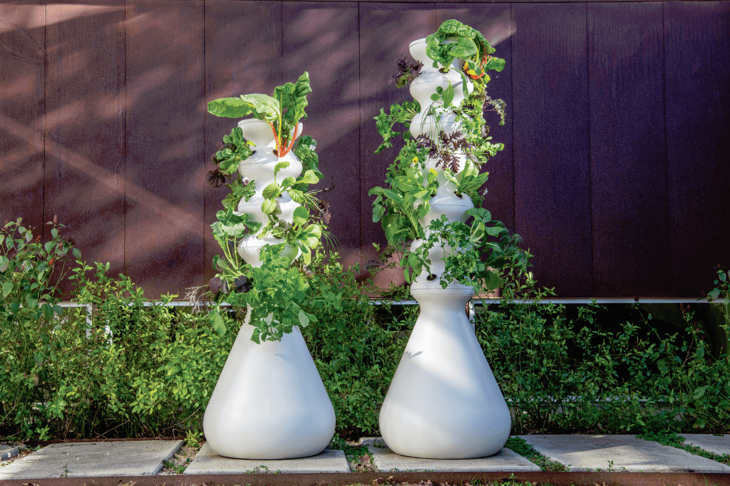
If you’re a lover of fresh, local produce and a champion of the environment, then growing some of your own food is likely at the top of your #homegoals list. But given the time and talent it takes to plant and maintain a vegetable garden, you may feel lost in the weeds.
Fortunately, Hollywood luminaries Zooey Deschanel and Jacob Pechenik have found a way to eliminate the most common obstacles to growing food at home. Last March, they launched Lettuce Grow, a business centered on a vertical hydroponic planter—called the Farmstand—that makes growing your own farm-fresh produce a no-brainer. With just five minutes of gardening per week, you can have a thriving edible garden.
Pechenik, who follows a plant-based diet, says that the goal is to make eating plants “more accessible, more affordable, [and] more fun.”
Foolproof farming
You don’t need much space to grow food with the Farmstand; it only needs three square feet of it. The self-watering, self-fertilizing unit can sit outdoors (anywhere that you’ve got a patch of sun and a power source) or—thanks to a newly available lighting kit—indoors.
You don’t even need gardening expertise. In raising a new plant from seed, “the hardest part is making sure it germinates,” says Pechenik. But Lettuce Grow takes care of that for you and then sends you baby plants (seedlings) that are ready for harvest in roughly two-and-a-half to four weeks.
Through the seedling delivery service, which is available everywhere in the contiguous United States, you can choose from 200-plus kinds of fruits, vegetables, and herbs—from seasonal staples like zucchini, mint, and baby lettuce to unusual varieties like burgundy broccolini, wasabi arugula, and nasturtium.
Nature meets tech
With the power of data, Lettuce Grow removes the guesswork from selecting which plants will flourish at your home—the other tricky factor for novice gardeners. “You tell us what you like to eat, and then, based off your zip code, we know the daylight index and the temperature,” says Pechenik. “So, we know what variety is best for you and when it’s going to grow best.”
The Lettuce Grow app for your iPhone or iPad guides you in the growing process. It reminds you when to add nutrients to the water or do a pH adjustment. The app also includes demonstration videos and a feature that Pechenik calls “Shazam for plants,” which helps you identify crops as they mature.
These farming solutions allow crops to be nurtured by information technology rather than unwanted chemical additives. To ensure success, “We aggregate knowledge and then give you what you need,” says Pechenik, who has a degree in chemical engineering from the Massachusetts Institute of Technology but now dubs himself “the anti-chemical engineer.”
Farm of the future
Pechenik believes this approach is a “leapfrog” in the way we conceptualize how our food is grown. “Rather than operating within the [industrial] food system, [Lettuce] is rethinking how we can be more efficient with the farm,” he says.
Growing seedlings instead of larger, more mature plants means Lettuce Grow’s farms can operate in urban areas and can accommodate up to 100 times more plants per square foot of soil than a traditional farm. Plus, shipping compact seedlings through the mail in recycled packaging adds up to fewer emissions than transporting mature plants in refrigerated trucks.
The Farmstand’s design also boosts efficiency at home. The tallest Farmstand, which holds 36 plants, yields what you’d expect to harvest from 40 square feet of raised beds. Crops grown in the vertical planter use 95 percent less water than crops grown in soil because in the closed system, not as much water is lost to runoff and evaporation. And harvesting your own fruits and veggies right when you want to eat them also reduces food waste—an important bonus given that up to 40 percent of food in the US gets thrown away instead of eaten.

Pechenik hopes the Farmstand can help usher in a new era of what’s called “distributed farming.” Rather than relying on industrial mega farms—which are located far away from population centers and threaten the health of the soil, climate, and individuals—more people can have small personal farms scattered across backyards and balconies.
“If everyone starts acting like farmers,” says Pechenik, “then we’ll have the world that we want.”
Farmstand Facts
- Made from 70+ recycled milk jugs
- Uses less electricity than a light bulb
- Expands vertically to accommodate from 12 up to 36 plants
- Yields up to 20 percent of your food needs
- Grows a head of lettuce with <1 gallon of water
- Costs $380 to get started, which includes the smallest Farmstand ($348), your first 12 seedlings ($32), and a Nutrients Pack for your first 100 plants
This article was originally published in the May/June 2020 issue of alive US, under the title \”Lettuce Disrupt the Food System.\”



